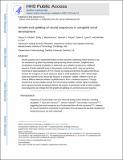Growth and splitting of neural sequences in songbird vocal development
Author(s)
Payne, Hannah L.; Okubo, Tatsuo; Mackevicius, Emily Lambert; Lynch, Galen Forest; Fee, Michale Sean
Downloadnihms725443.pdf (7.772Mb)
OPEN_ACCESS_POLICY
Open Access Policy
Creative Commons Attribution-Noncommercial-Share Alike
Terms of use
Metadata
Show full item recordAbstract
Neural sequences are a fundamental feature of brain dynamics underlying diverse behaviours, but the mechanisms by which they develop during learning remain unknown. Songbirds learn vocalizations composed of syllables; in adult birds, each syllable is produced by a different sequence of action potential bursts in the premotor cortical area HVC. Here we carried out recordings of large populations of HVC neurons in singing juvenile birds throughout learning to examine the emergence of neural sequences. Early in vocal development, HVC neurons begin producing rhythmic bursts, temporally locked to a prototype syllable. Different neurons are active at different latencies relative to syllable onset to form a continuous sequence. Through development, as new syllables emerge from the prototype syllable, initially highly overlapping burst sequences become increasingly distinct. We propose a mechanistic model in which multiple neural sequences can emerge from the growth and splitting of a commo n precursor sequence.
Date issued
2015-11Department
McGovern Institute for Brain Research at MITJournal
Nature
Publisher
Nature Publishing Group
Citation
Okubo, Tatsuo S. et al. “Growth and Splitting of Neural Sequences in Songbird Vocal Development.” Nature 528, 7582 (November 2015): 352–357 © 2015 Macmillan Publishers Limited
Version: Author's final manuscript
ISSN
0028-0836
1476-4687